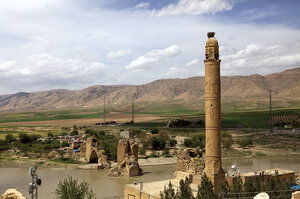Turkey's riverside refugees
The ancient Turkish city of Hasankeyf fights for survival as a new damn is planned.

A minaret juts upward from the El Rizk mosque, built in 1409 (foreground, r.) near the remains of a medieval bridge that crosses the Tigris River. When the proposed dam is filled, only about the top 12 feet of the minaret will be above water.
Jonathan Lewis
Hasankeyf, a city overlooking the Tigris River in the Southwestern Anatolia region in Turkey, prides itself on being the oldest inhabited settlement on earth. Having withstood the trials of millenniums and the occupation of civilizations from the Romans, Byzantines, Assyrians, Arabs, and Mongols to the Ottomans, all of whom left their mark, the ancient town now faces the threat of being flooded.
The construction of the Ilisu Dam, officially designed to improve the economy in Turkey's predominantly Kurdish southeast, would see the end to more than 6,000 years of permanent settlement and the relocation of 50,000 residents.
Firat Argun, who runs a guesthouse by the banks of the river, rallies against the construction of the dam. "Our roots are here, much like those of a tree," he says and gestures around him. "This is the only place where I am at peace."
His ancestors migrated to Hasankeyf from Baghdad 300 years ago, and like many local residents, he cherishes his Arab identity. His father and mother both grew up in one of the thousands of caves that dot the cliffs surrounding Hasankeyf where people used to live until the 1970s, when Süleyman Demirel, then prime minister of Turkey, ordered the construction of public housing and the relocation of the cave dwellers.
"The government declared Hasankeyf a protected historic area in 1978," Mr. Argun says. "We were not allowed to move even a single stone. How can they now come and flood the whole town?"
The remains of an early medieval bridge that once provided the only passage over the river to Silk Road travelers still withstands the currents of the Tigris today. The Zeynel Bey Mausoleum on the north banks of the river dates back to 1473, when the Turkic tribe of the Ak Kuyunlu made Hasankeyf its capital. With its Kufic patterns of glazed turquoise tiles covering the walls, the tomb is one of the few examples of Central Asian architecture in the Anatolia region.
More than 300 historical sites lie scattered in and around Hasankeyf, many of which remain unexplored and will be lost once the dam is finished.
Last July, in an overly hasty excavation of some archaeological sites using heavy machinery, a cliff collapsed and killed a man, according to Berne Declaration, a Swiss nongovernmental organization. After the accident, the authorities closed down the main historical site, which includes a Byzantine castle perched atop a cliff overlooking the Tigris. It was reopened last month.
Despite the dam's ongoing construction, the Ministry of Culture tendered for maintenance work on several historical sites last year, including the mausoleum and a medieval hamam, or public bath. Ali, a bricklayer from the nearby town of Batman, says: "I know that all of this will be flooded," pointing toward a low wall that has just been covered with cement. "So I am not sure why I am doing this."
Murat Cano, a lawyer from Istanbul, has been battling the project in court since 2000, arguing that the Ilisu Dam violates the Turkish law for the preservation of historical sites as well as the European Convention on the Protection of the Archaeological Heritage. "After the foreigners pulled out," he says, "the Turkish government has pretty much dropped all plans to protect the cultural heritage of Hasankeyf."
Despite the relentless protests both in Turkey and abroad, Turkish Prime Minister Recep Tayyip Erdogan has left little doubt about his determination to finish the dam. Last October, at the inauguration ceremony of state-built houses designed to accommodate the inhabitants of Ilisu Village who were displaced from their homes because of the dam, he ordered the acceleration of the opening date from 2016 to 2014.
Only shortly before, in July 2009, the dam's fate had been in doubt after Germany, Austria, and Switzerland withdrew their financial support for its construction, citing concerns about the project's social and environmental impact. The Turkish government quickly secured domestic financing for the €1.1 billion (about US$1.58 billion) project.
With relocations having started 100 kilometers (60 miles) downriver, residents of Hasankeyf are getting anxious. Ömer Güzel, a local activist who owns a corner shop, knows that the people of Ilisu are not happy with their new village: "It is very poorly planned. In their new houses, the people have neither farmland nor the possibility to keep animals. What are they supposed to do?" Pointing to the dust clouds rising from a construction site across the Tigris where "New Hasankeyf" is being built by the state housing agency, he says: "It feels like we will be buried alive and all we can do is sit and watch them dig our graves."
But Mr. Cano's determination to challenge the dam may bear fruit: In March, a local court in Diyarbakir ordered an investigation into Hasankeyf's cultural value and into the potential damage the dam might cause. The findings will be presented in a report by the end of June.
"The Ministry of Culture has no feasible plans on how to move and protect historical monuments. They are not even sure which monuments will be relocated," Cano says. "If the assessment report is written by international preservation standards, the Ilisu Dam project will be scrapped."
